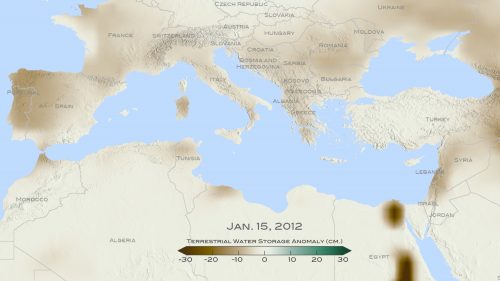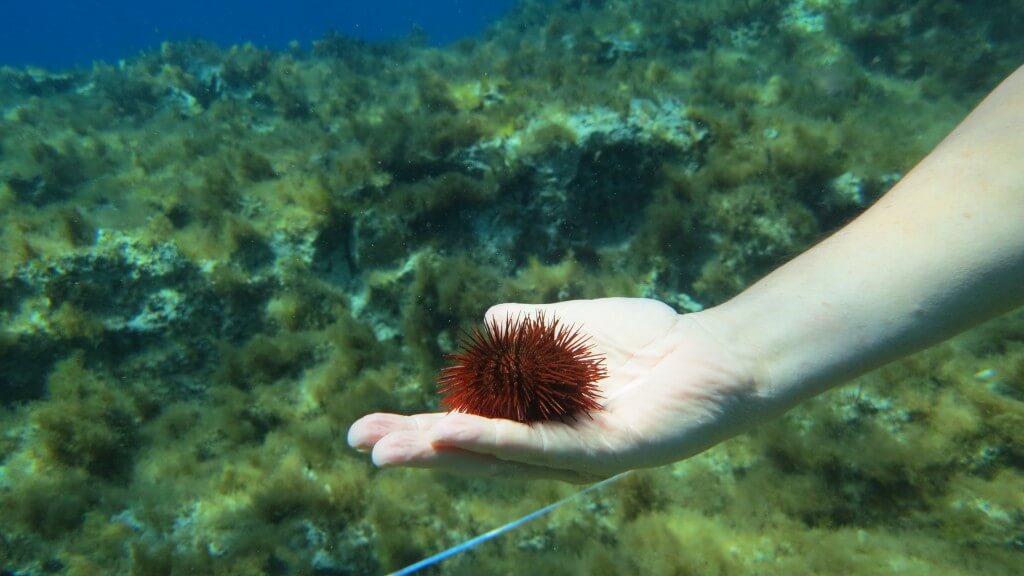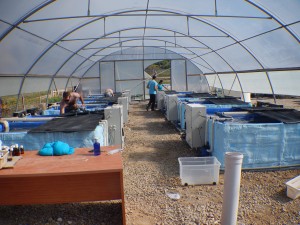The Mediterranean Sea has warmed by three degrees in the last three decades, according to a new report by the Seas and Lakes Research Institute. How does this warming affect the marine creatures and the oxygen we breathe?

More of the topic in Hayadan:
- The drought in the eastern Mediterranean - the most severe in the last 900 years
- Atlantropa - a crazy plan that was seriously considered to dam the Mediterranean Sea for energy production
- Did a tsunami wash the shores of Israel in the second century AD?
By Maya Falah, Angle - news agency for science and the environment
If it seemed to you that the sea today is warmer than the sea you remember from your childhood, now the measurements show that your feelings are correct. A recently published report by the Seas and Lakes Research Institute on the state of the Mediterranean Sea for 2013-2014 states that the Mediterranean Sea is warming at a rate of about 0.1 degrees per year on average - and in total it has warmed by about three (!) degrees Celsius in the last three decades. The warming of the sea may make it more pleasant to swim in, but it has enormous environmental consequences. It occurs as part of the global warming trend, which significantly affects all the ecological systems on Earth, including the marine systems - which constitute a significant percentage of its surface.
In recent years, the water temperature in the Mediterranean has reached a record of 31.5 degrees every year, a temperature that used to be rare in the region. Limited information from the past, along with monitoring operations and surveys conducted today, indicate that marine creatures that were common in our region until about a decade or two ago are disappearing, or have already disappeared completely. Dr. Gil Rilov, head of the Laboratory for the Ecology of Marine Societies at the Sea and Lakes Research Institute, who co-wrote the report, conducts these monitoring operations and surveys on Mediterranean reefs, and also investigates in his laboratory the phenomenon of the disappearance of species in this habitat. "Besides many species that are harmed by overfishing or local pollution, there are many others whose populations have collapsed or completely disappeared along the entire coast, and the reason for this is unknown," he says.
About two years ago, Erez Yeruham, a student in Rilov's laboratory, conducted a study that examined the possible reasons for the disappearance of sea urchins, which used to be very common on the coasts of Israel as in the rest of the Mediterranean Sea. "It seems that the hedgehogs are not coping well with today's summer", Rilov explains. "In the laboratory we clearly saw that they do not survive a water temperature higher than 30.5 degrees, and today the sea reaches these temperatures every year at the height of summer. When they are exposed to water that reaches the peak temperatures that were common in the nineties, about 29 degrees, the percentage of survivors is much higher, so it is clear that the warming of the sea plays a fundamental role in the disappearance of this species, which was very common here in the past. However, a combination of other factors cannot be ruled out, such as competition for food with vegetarian fish that invaded the Red Sea a few decades ago and are eliminating most of the algae mats that the urchins also fed on. This competition can harm the growth and reproduction of the hedgehogs, thus weakening their resistance to the increase in temperature."

On your way to a tropical sea?
In addition to sea urchins, many other species have disappeared from the shores of the country in recent years, such as the red-mouthed scarlet snail, which was common in our places back in biblical times and was then used to dye royal clothes crimson, and the beaver snail - a snail that plays an important role in stopping theWeathering of the grading tables, a unique habitat found on the coasts of the country. Disappearance of species in the sea can be due to many factors such as overfishing, destruction of habitats, pollution of the sea water, invasive species that push the local species in competition for food or predation and acidification of the sea water. But all of these phenomena can be linked indirectly or directly to human activity, and some of them specifically to climate change and global warming.
"We are witnessing the disappearance of dozens of local species and maybe even more" says Rilov. "One explanation is that it is related to climate change. In my lab we study these effects on the native species and also on a number of invasive species, and try to understand and isolate what actually causes their disappearance. Tamar Guy-Haim, a doctoral student in the laboratory, tries to predict what will happen in the future to the entire reef system with the help of unique experimental systems that monitor the conditions in the sea, and at the same time simulate the predicted conditions of temperature, water acidity or both as climate change increases.
"At the same time as warming, there is also a phenomenon of the penetration of many invasive species from the Red Sea into the Mediterranean through the Suez Canal, which affects the local ecosystem. Many of the native species are not adapted to the new record sea temperatures, while the invasive species tested can survive at higher temperatures. Because of this, in a warmer world, the invasive species have an advantage and they succeed in multiplying and thriving in the local habitats, replacing the species that were common in the past. Some of the invaders have completely new properties in the system, so they can have a far-reaching effect on the functioning of the entire ecosystem." One of the concerns in this context is that the invasive species change the composition of the eastern Mediterranean ecosystem - which is based on a subtropical climate and accordingly supports unique species that characterize such a climate - and make it have tropical characteristics that do not support these species.

Lab hedgehogs
Is there anything to be done about it? In an article published in 2014 And based on a survey of many researchers from the fields of biology and ecology in Israel, the best experts are trying to answer the question and formulate policy recommendations to preserve the ecosystems in Israel in the shadow of climate change. One of the recommendations regarding marine systems is to transfer species at risk to laboratory conditions for conservation, and try to return them to nature after the restoration of the system. According to Rilov, "What is missing today is mainly knowledge and understanding of the reasons and trends behind the disappearance of species in order to try to predict what will happen in the future and restore the system and its functions. At the moment there is no point, for example, in growing sea urchins in a laboratory and trying to return them to the sea, since they most likely will not survive the current conditions. We lack a lot of data, and since they only started investing in monitoring in the last few years, it is impossible to know what was in the past and to understand the trend of change." One of the solutions being discussed in favor of restoring the tying tables, for example, in the event that they fail to restore the beaver population, is the construction of eco-concrete strips on top of the tying tables that will replace the cornice created by the snail at the edge of the table.
To begin conservation and restoration efforts, it is important to understand the contribution of endangered species to the ecosystem. This way it will be possible to try to restore their function in the system or to replace them to prevent its collapse. "What is already extinct - it is impossible to study, but what still exists is important to try to understand", says Rilov. "In this context, one of the experiments carried out by Ohad Peleg, from Sternat in the laboratory, is the placement of transparent domes over native and invasive algae, under the surface of the water, in order to capture the oxygen released by the algae and thus check their photosynthesis rate. Thus it is possible to understand how the system changed following the appearance of invasive species. The experiment examines what the reef has lost due to herbivorous invasive fish that harm the local algae, and whether certain invasive algae, which are spreading over the reef, replace some of the lost system functions. This way we can understand what was lost, and perhaps try to complete it in some way."
"It is important to note that it is possible that some of the functions of the disappeared species are currently provided by the invasive species," Rilov adds, "and this also needs to be investigated and understood. This is research that is still in its infancy."
the source of oxygen
Global warming is a documented phenomenon whose effects are evident, and in recent years there has been a growing understanding in the world that it is necessary to prepare for it as soon as possible. "These days, a national report was written by Israeli experts on the state of the ecosystems in Israel, which focuses on the services these systems provide for the benefit of man - both as an economic contribution, and contributions that cannot be quantified economically, such as the very enjoyment of nature," says Rilov. "I am among the writers of the maritime chapter, and we face a difficult task, mainly because of the lack of basic knowledge and because of the difficulty of translating biological knowledge into values that the public can easily understand. A healthy marine ecosystem has, for example, the ability to break down infections up to a certain level, which is a service it provides to man. There are also services that the system provides that are extremely essential for human existence: for example, a significant portion of the oxygen on Earth is produced by marine creatures, so if the marine system collapses we will not be able to survive - because we will have no source of oxygen. There are many cute creatures, such as panda bears or dolphins, that are in the public awareness and it is clear to everyone that they need to be protected, but one must understand that there are also many creatures that we do not see, but their very existence also enables our existence."
"Nature is complex", concludes Rilov, "not necessarily one factor such as warming determines the survival or extinction of a species, but a collection of factors can create a rolling effect. The presence of an invasive species that pushes the sea urchin out of competition for food may make it more sensitive, and then the warming of the water, or maybe some virus, comes and wipes it out completely. What is clear to us today is that the change we are seeing is enormous, and we need to study it and understand it better so that we can act accordingly and maintain the functioning of the systems as much as we can."

2 תגובות
exciting
Why open a new report when it is a news cycle that was published verbatim six months ago?